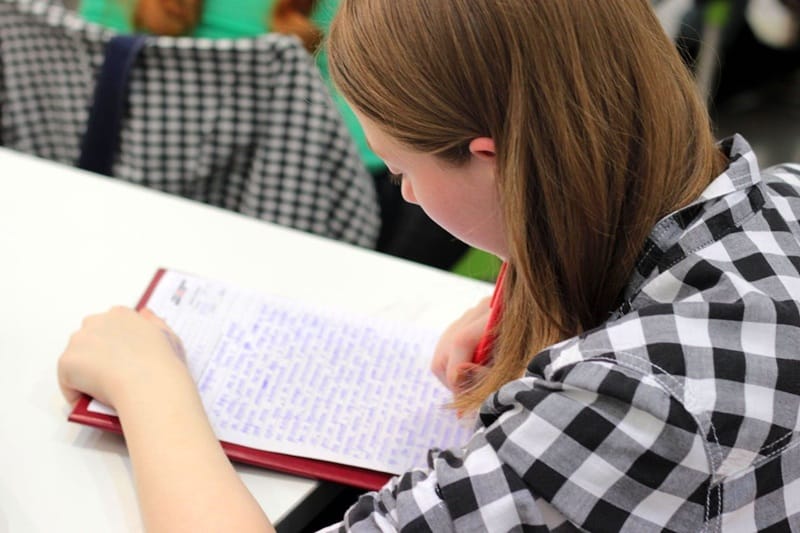Assignments – Write versus Right

Way back in “my day”, we sought information from the stacks of books and journals in a physical library, keeping notes and compiling our own thoughts and theories from the data of our own work, as reflected against and/or supported by the published materials to which we had (or could acquire) access. Contrastingly, in “the Internet Age”, one need merely “Google” a few terms, cut & paste a few pointers, mess them about a bit to avoid detection by “Turnitin”, and, Voila! – assignment complete. Regrettably, submitters learn very little from this process, and exacerbate this fault with the risk of a phenomenon I’ve always termed “accidental plagiarism”.
This insidious beast is fed through a common poor practice amongst today’s students who work with multiple “Windows” open upon their desktop – several reference sources and their assignment document, for example. In such a work process it is all too easy to see how the expediency of the cut-paste-amend process can become even more streamlined with less use of the amend component.
As my old biology mentor once told me:
You can never cheat in science, because you will always get caught. It might take years but, eventually, someone will find out what you did. Do you really want that as your legacy?
Here was a concept that resonated with me so fully that I have extrapolated the idea into every facet of life, and I have always tried to inculcate the same values into my teaching.
I perceive learning as the central hub of all our lives, just as the sharing of that learning must be the goal. Hence, when my students over the years have lamented upon not being able to retain information, or even to appropriately source, cite and utilise information for assignments and exams, it struck me that the problem was largely a matter of poor habits and Internet usage, rather than ill intent. Perhaps, I surmised, it is simply that they do not have the confidence or training to recognise what plagiarism is, or how inherently distinct are knowledge and information and intelligence and wisdom and skill.
First, to address a common defence I have too often heard at disciplinary hearings:
“But, the stuff I copied came from Wikipedia, and that isn’t copyright!”
The University of Oxford defines “plagiarism” as: “presenting someone else’s work or ideas as your own, with or without their consent, by incorporating it into your work without full acknowledgement. All published and unpublished material, whether in manuscript, printed or electronic form, is covered under this definition. Plagiarism may be intentional or reckless, or unintentional.”
Copyright, in contrast, is a legal term conferring protection under the law for literary property and, whilst copyright materials are obviously not available for unreferenced use in an assignment, the above definition by Oxford makes it clear that this prohibition is not limited to such materials. Regardless of these moralities, however, any student is smarter than Google and will know their class and their subject better than Wikipedia or some “essay-writer” hired over the Internet, just as the teacher will know the style of an individual student’s work in comparison to that of their classmates.
Moreover, and beyond such ethical reproaches and legal distinctions, isn’t it evident that the “Google-cut-and-paste” process is self-defeating, whether or not the plagiarism software catches you? Similarly, getting someone else to write the assignment for you gains you nothing but a transient grade (if you’re lucky). After all, theft is theft, however intangible the item stolen, and the entire “so long as I pass” approach to learning that such cheating supports is not only ultimately counter-productive, but also abysmally lazy.
One’s purpose in school is to learn and understand, to grow as a person and acquire the skills, habits and knowledge that will enable you to become not only a productive member of our global community, but also a happy one. You are not in class to have information shovelled in one end merely to regurgitate it back out upon command. Certainly, knowledge is valueless without understanding, just as success is an empty prize if it has been attained purely by riding upon the backs of others – even if one circumvents the “theft” concept by paying those “others” for their illegitimate academic contribution.
Onwards to the more philosophical concept noted above, and how the intelligent man only recognises that it is raining, whereas the wise man seeks shelter.
I inferred earlier that knowledge and information are easy – Google has these almost without limitation – but, the intelligent utilisation of the information one can access, and acquiring the skill, experience and wisdom to discern truth from fantasy or blatant subterfuge and, thereby, to create a new paradigm or a new concept, or to find new meaning or a new utility for that knowledge and information; those are hard – and, hence far more worthy of one’s focus and effort than is the honing of one’s Google-search or Turnitin-defeating skills.
As a consequence of holding many discussions along the above lines with my students, I felt it prudent (alright, temporally efficient) to condense the points I wanted them to understand into as succinct a “menu” as possible.
What follows is the result, and I hope it will help upcoming generations of students not only to excel in their immediate studies, but to revitalise their own holistic educations – to begin again to understand what an increasingly cynical humanity has largely, if gradually, lost sight of: that each of us can achieve whatever we dream to achieve – if we are prepared to work hard enough, with an open-mind, and an honest heart; with passion, commitment and a full view of the contributions we can make not just to our own lives, but to the lives of those we love, those they love and those who love us in return.
So, dream big and remember the words of John F. Kennedy: “We choose to go to the moon in this decade and do the other things, not because they are easy, but because they are hard, because that goal will serve to organise and measure the best of our energies and skills, because that challenge is one that we are willing to accept.”
Now, for those practical tips – a sort of “clip-notes” abbreviation of an oft-repeated sermon that became known as:
“The Director's Address on Writing Assignments”
Step 1: Start early – don't wait until the night before your submission is due and then panic to get something submitted on time. Whilst it is not always true that “anything is better than nothing”, it is always true that preparation is key to success.
Step 2: Do not simply skim the question or topic posed, but analyse it. Consider the exact phrasing of the question and design your answer plan so that it is framed to that phrasing. Part of this planning or mapping process is to determine a set of sub-questions that will help you build a complete and clear answer to the parent question. For example: are you required to explain, describe, or compare/contrast? Is it a formal report, a straightforward essay, a direct question-and-answer sequence, or a poster type of submission? How can you break the parent question down into manageable parts that can be addressed appropriately within the selected format?
Step 3: Next, you must seek out legitimate (and multiple) sources of information. Use both general and specific domains from textbooks, course notes, peer-reviewed papers, personal communications, first person research and experience; but always keep records of where you gathered the information. Discuss with your mentors, teachers and classmates, go to the library, but, please, don’t use Wikipedia.
Ok, if you insist, use Wikipedia as a first touchstone in cases where you are really lost for a place to start. This should, of course, be very rare and you must not fall into the common trap of relying upon the materials in Wikipedia (or any source without formal peer-review) as “gospel truth”, nor as your only source of information. Above all, Wikipedia should never become your starting point, pathway and finishing line for an assignment.
Step 4: Take HANDWRITTEN bullet notes from the sources you have identified and assign these notes to address the relevant sub-questions you’ve compiled in your answer plan. Cross-reference and highlight them as necessary to ensure you do not duplicate points, or miss anything important.
Step 5: Close all original references (and computer files) and begin to put together a first draft of your assignment based upon your handwritten notes and memory alone. Use this phase to figure out what will make the difference between “just passing” and passing really, really well; create a framework or scaffold upon which to build your submission. The struts of such a scaffold will be based upon your school’s standard practices, but the general design is likely to be something along the lines of:
- Introduction or opening statements (sometimes, this is a rephrasing of the question with appropriate elaborations).
- Body of the essay (“the answer”). This needs to show a suitable structure by ordering the sequence in which each sub-question is addressed; it might be chronological, consequential, source-related or designed according to numerous other logical rationalizations.
- A conclusion and/or discussion – wherein you return to the original question and demonstrate how “the answer” you have provided addresses it fully and with references.
- References, citations, et cetera. In general, every work referred to in your text must be included in a references section at the end of your assignment. No work may be included in this references section, however, if it has not been properly cited in the text being submitted (such additional readings would, instead, form part of a separate “Bibliography”). But, again, follow your school’s specific guidelines on how to cite your references – those guidelines should include explanations regarding citations, references, bibliographies, quotations and other sourcing.
Step 6: Once you have bashed out something, double-check this first draft against your notes, then against the original sources; correct any errors and fill in any gaps you feel remain to address the full question in your next draft. Ensure that everything is consistent with the question, as well as with your introduction and conclusion. Revamp things as necessary to make the story you are telling complete, non-repetitive, without internal conflict or contradiction (unless that is your justified intent) and clear. Then, repeat this process until you have addressed the full question and each of the sub-questions.
Step 7: Polish your final draft: check spelling, syntax and grammar, double-check against copied phrases (or minimally rephrased passages). Don't be tempted to pad your answer in the hopes of gaining scattergun hits/points. Be bold enough to cut superfluous material that does not benefit the answer. As a rule-of-thumb: if it clouds the issue or adds little to the reader's understanding of the specific points you need to address, or if it is simply filling space to show-off extraneous knowledge, delete it. Ensure that you have provided all relevant references/citations, and that any quotes are indicated as such − but do keep quotations to a minimum (use them as a delicate seasoning, not to form the dish itself).
Step 8: Finally give yourself a day away from the assignment to “breathe” and refresh yourself, then read the question again. This is one of many reasons why Step 1 above is so important. Next, re-read your assignment. Does this “pre-submission” accurately, clearly and completely address the question? Is it framed appropriately, and written in your own words? Have you utilised up-to-date sources of information – and justified and verified them? Does it read well? If you can honestly answer “yes” to each of these QC checkpoints, you are ready to submit. But, if you are uncertain of your work, go back through all of the above, and seek further guidance from your tutors.
Bonus Point
Something NOT to do: You are strongly advised against asking for help on a specific assignment from your peers – unless, of course, it is group work. Other than for such a group assignment, involving a classmate in your submission risks both of you being caught in that “accidental plagiarism” problem again.
And, no, this is not a selfish directive. On the contrary, the outcomes of even the most innocent of unauthorised “team-work” will be unpleasant both academically (disciplinary hearings, academic penalties, failed assignments/modules, expulsion, et cetera) and socially. This is because, having seen your efforts, your friend might inadvertently use some of it in their own submission, or they might yield up some of their own words in an attempt to aid your understanding.
In either case, your teacher will not be able to differentiate the copier from the copied, and it won't matter that it was unintentional. Perhaps worst of all, the blame-game that is ultimately likely to ensue − with one word against the other − will not stop the punishment, but may cost you a friendship.
Just share sources, and discuss ideas, but never your work.
By routinely (or, better, ubiquitously) using the above steps for your work, a few things will happen:
Outcome 1: “Accidental plagiarism” is prevented – and this includes those somewhat nebulous concepts of “academic poor practice” (cut and paste, eye-to-hand-bypassing-brain-type stuff, citation/referencing negligence, or proclamations of innocence through ignorance). Hence, you mitigate your chances of failing the assignment through academic penalty, or of being called to a disciplinary hearing for possible expulsion.
Outcome 2: The information you gather passes through your brain several times, via several memory loops (writing things out by hand is believed to improve both retention and comprehension by a considerable margin) and will not only, thereby, improve your performance in the specific assignment, but in subsequent ones and in the exams (as well as in your future careers).
Outcome 3: You will develop an invaluable habit that can be applied again and again throughout your life, gaining considerable advantages for your future self.
In the end, and above all else, remember these three things:
- There is no such thing as a stupid question. So, don't be afraid to ask your teacher/lecturer for help.
- Never become disillusioned – not even the most published author is perfect every time (not even much of the time, actually)!
- Like any new type of exercise regime, this process will seem a little arduous and perhaps even painful at the start. Certainly, it will require consistent and sustained effort to ingrain. But, it will all pay dividends, and the practice will soon become as simple and spontaneous as habit.
Finally, I will share the motto of my alma mater, which is: “Do Different”.
Thus, in encouraging you all to embrace your weirdness (as well as the weirdness of others), I hope the concepts touched upon in this article will also enable you to break from an increasingly common practice of rehashing the work of others and representing it unfairly as your own. Instead, seek your own excellence, revel in the unique “you” and be recognised in the light of the attributes and attainments you have earned.
Strive to honour your ancestors, your descendants and your peers and mentors – but, most importantly, to honour yourself. Bolster yourself with the knowledge that learning is a lifelong journey, and the ride is best when your skills are tested – as only then are you rewarded with a surge of pride in what you have achieved.
Never stop trying, never stop learning, and never, ever cheat.
Last Updated on 28 January 2025
Andrew P. Lucy obtained his PhD in molecular biology at the John Innes Centre (University of East Anglia) in the UK and has supplementary qualifications in natural medicines and psychotherapy. Dr Lucy has published peer-reviewed articles and opinion pieces across a number of disciplines – from communications and change to education and career management to biological sciences, and even the odd bit of poetry. His experience spans bench research, laboratory and business partnership and development, education and professional coaching.





